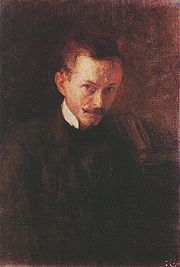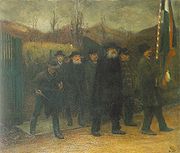
István Réti
Encyclopedia


Hungary
Hungary , officially the Republic of Hungary , is a landlocked country in Central Europe. It is situated in the Carpathian Basin and is bordered by Slovakia to the north, Ukraine and Romania to the east, Serbia and Croatia to the south, Slovenia to the southwest and Austria to the west. The...
painter, professor, art historian and leading member, as well as a founder and theoretician, of the Nagybánya artists' colony.
Réti, born in Nagybánya
Baia Mare
Baia Mare is a municipality in northwestern Romania and the capital of Maramureş County. The city is situated about 600 kilometres from Bucharest, the capital of Romania, 70 kilometres from the border with Hungary and 50 kilometres from the border with Ukraine...
(from 1918 Baia Mare
Baia Mare
Baia Mare is a municipality in northwestern Romania and the capital of Maramureş County. The city is situated about 600 kilometres from Bucharest, the capital of Romania, 70 kilometres from the border with Hungary and 50 kilometres from the border with Ukraine...
, Romania
Romania
Romania is a country located at the crossroads of Central and Southeastern Europe, on the Lower Danube, within and outside the Carpathian arch, bordering on the Black Sea...
), began his studies at the Budapest School of Drawing in 1890 but left after a month. From 1891 he studied at Simon Hollósy
Simon Hollósy
Simon Hollósy ; was a Hungarian painter. He was considered one of the greatest Hungarian representatives of 19th century Naturalism and Realism. Hollósy was not productive as an artist: he was in search of atmospheres and his productivity was confined to teaching...
's free painting academy in Munich
Munich
Munich The city's motto is "" . Before 2006, it was "Weltstadt mit Herz" . Its native name, , is derived from the Old High German Munichen, meaning "by the monks' place". The city's name derives from the monks of the Benedictine order who founded the city; hence the monk depicted on the city's coat...
, and later at the Académie Julian
Académie Julian
The Académie Julian was an art school in Paris, France.Rodolphe Julian established the Académie Julian in 1868 at the Passage des Panoramas, as a private studio school for art students. The Académie Julian not only prepared students to the exams at the prestigious École des Beaux-Arts, but offered...
in Paris
Paris
Paris is the capital and largest city in France, situated on the river Seine, in northern France, at the heart of the Île-de-France region...
. Returning home, he painted his first significant work, Bohémek karácsonyestje idegenben ("Christmas Night of the Bohemians Abroad", 1893). This nostalgic lamplit interior, typical of the period, was exhibited at the Palace of Art
Palace of Art (Budapest)
*Kunsthalle Budapest is a contemporary art museum in Budapest. The building, built in 1895, is located in Heroes' Square, facing the Museum of Fine Arts....
and purchased by the state. In 1894 he travelled to Turin
Turin
Turin is a city and major business and cultural centre in northern Italy, capital of the Piedmont region, located mainly on the left bank of the Po River and surrounded by the Alpine arch. The population of the city proper is 909,193 while the population of the urban area is estimated by Eurostat...
, where he painted Kossuth Lajos a ravatalon ("Lajos Kossuth
Lajos Kossuth
Lajos Kossuth de Udvard et Kossuthfalva was a Hungarian lawyer, journalist, politician and Regent-President of Hungary in 1849. He was widely honored during his lifetime, including in the United Kingdom and the United States, as a freedom fighter and bellwether of democracy in Europe.-Family:Lajos...
on His Bier"); the revolutionary had just died there. He was attracted by the work of Jules Bastien-Lepage
Jules Bastien-Lepage
Jules Bastien-Lepage , was a French naturalist painter, a style related to the Realist movement.-Life and work:...
, and an 1895 trip to Paris introduced him to the work of Pierre Puvis de Chavannes
Pierre Puvis de Chavannes
Pierre Puvis de Chavannes was a French painter, who became the president and co-founder of the Société Nationale des Beaux-Arts and whose work influenced many other artists.-Life:...
.
Together with János Thorma
János Thorma
János Thorma was a Hungarian painter. A representative figure of the Nagybánya artists' colony, his work progressed from naturalism, to historical subjects, to romantic realism to a Post-Impressionism of a style specific to Nagybánya .Born in Kiskunhalas, Kingdom of Hungary, Austria-Hungary to the...
, Réti helped persuade Hollósy to move his school to Nagybánya and in 1896 was one of the founders of the artists' colony there. Starting in 1902 he was a professor at its free painting academy, and in 1911 he was one of the founders of the Nagybánya Painters' Association. Although he moved to Budapest
Budapest
Budapest is the capital of Hungary. As the largest city of Hungary, it is the country's principal political, cultural, commercial, industrial, and transportation centre. In 2011, Budapest had 1,733,685 inhabitants, down from its 1989 peak of 2,113,645 due to suburbanization. The Budapest Commuter...
in 1913 to teach at the University of Fine Arts
University of Fine Arts Budapest
The Hungarian University of Fine Arts is the central Hungarian art school in Budapest, Andrássy Avenue...
, he continued making improvements to the Nagybánya school in summer and taught there until 1927. From 1920 he worked to reform the university according to Nagybánya principles together with Károly Lyka, serving as its president from 1927 to 1935 before retiring in 1938. He spent the last decade of his life writing a history of the Nagybánya artists' colony, and died in Budapest.
In his first phase as a painter, Réti's chief interests were light and interiors, especially lamps or sunlight streaming through windows (Gyötrődés — "Cacophony", 1894; Öregasszonyok — "Old Women", 1900; Kenyérszelés — "Slicing the Bread", 1906). The plein air
En plein air
En plein air is a French expression which means "in the open air", and is particularly used to describe the act of painting outdoors.Artists have long painted outdoors, but in the mid-19th century working in natural light became particularly important to the Barbizon school and Impressionism...
landscape painting programme at Nagybánya did not have much influence on him. In 1899 he produced one of his best-known canvases, Honvédtemetés ("Burial of a Hungarian Soldier"), which referred to the 1848 revolution
Hungarian Revolution of 1848
The Hungarian Revolution of 1848 was one of many of the European Revolutions of 1848 and closely linked to other revolutions of 1848 in the Habsburg areas...
; the unity of the landscape and people is bound together by the grey of the dusk. In 1904–07 (the last two years working in Rome
Rome
Rome is the capital of Italy and the country's largest and most populated city and comune, with over 2.7 million residents in . The city is located in the central-western portion of the Italian Peninsula, on the Tiber River within the Lazio region of Italy.Rome's history spans two and a half...
) he painted several variations of Krisztus apostolok között ("Christ with the Apostles"), his most significant religious work. After 1910 he created several decorative paintings, such as Cigánylány ("The Gypsy Girl", 1912), and many portraits and self-portraits, including one of Kossuth in 1931. In his later years, Réti worked relatively slowly, taking long breaks between paintings and undertaking theoretical preparation for each new one. It is probably due to this fact that his oeuvre is rather inconsistent; as he concentrated on teaching, his output diminished in both quality and quantity. From an early age he was preoccupied by contemporary questions of artistic theory, which he also tried to explore as a professor; after 1920 his written output on artistic subjects increased in quantity, and his writings on aesthetics, influenced by Croce
Benedetto Croce
Benedetto Croce was an Italian idealist philosopher, and occasionally also politician. He wrote on numerous topics, including philosophy, history, methodology of history writing and aesthetics, and was a prominent liberal, although he opposed laissez-faire free trade...
and Bergson
Henri Bergson
Henri-Louis Bergson was a major French philosopher, influential especially in the first half of the 20th century. Bergson convinced many thinkers that immediate experience and intuition are more significant than rationalism and science for understanding reality.He was awarded the 1927 Nobel Prize...
, had a more profound effect than his painting or teaching activities.

